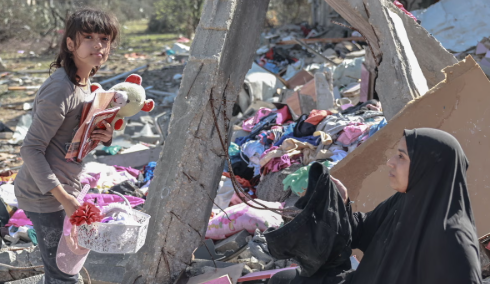The Cost of Conflict: Human Suffering in Gaza, Lebanon and Israel
The ongoing conflict between Israel and Hamas, which erupted in October 2023, has evolved into one of the deadliest confrontations in recent history, leaving behind an alarming trail of human casualties and suffering. Beyond the geopolitical complexities and the ideological divides, the conflict has inflicted irreparable harm on innocent civilians—men, women and children—who bear the brunt of a war they did not choose. The devastation in Gaza, the casualties in Israel and the spillover effects in Lebanon paint a grim picture of the human cost of war.
The Human Cost in Gaza
The Gaza Strip, home to over 2 million Palestinians, has endured relentless airstrikes and a prolonged blockade, making it one of the most densely populated and impoverished regions in the world. Since the escalation, Israeli airstrikes have targeted Hamas infrastructure, but the collateral damage to civilians has been staggering. Entire neighborhoods have been reduced to rubble, hospitals overwhelmed, and basic infrastructure obliterated.
Casualties and Displacement
As of December 2024, reports indicate that over 15,000 Palestinians, including women and children, have lost their lives. Thousands more are injured, many critically. The destruction of homes has left over a million people displaced, seeking refuge in overcrowded shelters, schools, or makeshift camps. The lack of clean water, electricity, and medical supplies has compounded the humanitarian crisis, leading to outbreaks of disease and widespread suffering.
Impact on Children
The psychological impact on Gaza's children is perhaps one of the most tragic consequences. Living under constant bombardment, they suffer from trauma, anxiety and depression. Schools have been turned into shelters or destroyed, depriving them of education and a sense of normalcy. The future of an entire generation is at risk, trapped in a cycle of violence and despair.
Casualties in Israel
On the Israeli side, the conflict began with an unprecedented attack by Hamas, which launched thousands of rockets into Israeli territory and carried out a brutal ground assault. The surprise attack resulted in the deaths of over 1,400 Israelis, including civilians who were massacred in their homes and at public gatherings. The atrocities shocked the world, highlighting the ruthlessness of the militant group and the vulnerability of Israeli border communities.
Rocket Fire and Civilian Casualties
Hamas’s continued rocket fire has caused additional civilian casualties in Israel. Although Israel’s Iron Dome defense system intercepts most rockets, some evade detection, causing fatalities and injuries. Urban centers, schools, and hospitals have been targeted, leaving civilians in constant fear. The psychological toll on Israelis, particularly children who grow up with the sound of sirens and the fear of rockets, cannot be overstated.
Lebanon: A Ticking Time Bomb
The conflict has not remained confined to Gaza and Israel. In Lebanon, Hezbollah—a militant group aligned with Hamas—has launched sporadic attacks on Israel, leading to retaliatory strikes. Civilians in southern Lebanon, caught in the crossfire, have suffered immensely. While the casualties in Lebanon are not as high as in Gaza or Israel, the looming threat of escalation poses a grave danger to the region.
Displacement and Losses
Thousands of Lebanese civilians have fled their homes in border areas, since the Israeli ground invasion. The displacement adds to Lebanon's existing economic and political turmoil, further destabilizing the fragile state. For those who remain, the lack of access to humanitarian aid and medical facilities exacerbates their plight.
A Cycle of Retaliation
The Israel-Hamas conflict has become a relentless cycle of retaliation, with each side justifying its actions as a response to the other. Hamas claims to represent Palestinian resistance against occupation, while Israel defends its actions as necessary for its security and the survival of its people. In this deadly tit-for-tat, civilians are collateral damage.
International Law and Accountability
Human rights organizations have raised concerns over violations of international law by both parties. The indiscriminate targeting of civilians, the use of human shields and the disproportionate use of force are among the issues flagged. Calls for accountability have grown louder, but meaningful action remains elusive, as global powers struggle to find common ground.
The Role of the International Community
The international community’s response to the conflict has been polarized and, at times, inadequate. While some nations have unequivocally supported Israel’s right to defend itself, others have condemned its actions as disproportionate and inhumane. The United Nations has struggled to broker a ceasefire, as geopolitical rivalries among major powers hinder consensus.
Humanitarian Aid
Humanitarian organizations have been working tirelessly to provide aid to affected populations, but access to Gaza remains a significant challenge. The blockade, coupled with ongoing airstrikes, has made it nearly impossible to deliver essential supplies. Lebanon, too, has seen limited international assistance, further exacerbating the suffering of its people.
A Path Forward: Ceasefire and Negotiations
Ending the bloodshed requires an immediate ceasefire and a return to negotiations. However, the deep-seated animosity and mistrust between Israel and Hamas make this a daunting task. Any long-term solution must address the root causes of the conflict, including the blockade of Gaza, the occupation of Palestinian territories and the security concerns of Israel.
Two-State Solution
The two-state solution, once widely regarded as the most viable path to peace, remains elusive. Renewed efforts by the international community to revive this framework are essential. Both Israelis and Palestinians deserve to live in peace and security, free from violence and fear.
The Human Toll: A Stark Reminder
The ongoing conflict serves as a stark reminder of the devastating human cost of war. Behind the statistics are real people—families torn apart, children orphaned and communities destroyed. The stories of loss and resilience from Gaza, Israel and Lebanon must not be forgotten. They underscore the urgent need for a peaceful resolution, one that prioritizes human lives over political agendas.
In conclusion, the Israel-Hamas conflict is a tragic example of how war dehumanizes and devastates. As the world watches in horror, it must also act—with compassion, urgency and resolve—to bring an end to the suffering and pave the way for a future where such atrocities are never repeated. Only then can we truly honor the lives lost and the enduring spirit of those who survive.


